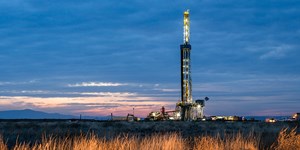Industry endures the Big Plunge
Not since the great price collapse of 1986 has the global upstream industry seen such a major downturn in oil prices and activity, particularly in North America, as has occurred from late 2014 forward. Initially, most analysts and company CEOs in the E&P sector were hopeful that the initial downturn in prices experienced in late 2014 would only last several quarters.
However, it became apparent by mid-2015 that despite some temporary, moderate improvement in oil prices, the downturn was by no means over, and it would last well into 2016. Much like 1986, when drilling fell 45%, from 71,108 wells to 38,809 wells, the free-fall in U.S. activity during 2015 was quick and sizeable. Activity during 2015 fell 40.6%, from 48,326 wells to 28,692 wells.
Tracking the numbers. And the outlook for 2016 has worsened with time. Initially, World Oil’s forecast for 2016 called for a 33.2% reduction in drilling, to 19,179 wells. But as the Baker Hughes rig count for the U.S. dropped rapidly, from 664 units on Jan. 8, to just 489 eight weeks later, it became apparent that this forecast would not hold up until mid-year. Thus, the new interim forecast, as of late April 2016, calls for just 17,533 wells, a 38.7% decline in U.S. activity.

Our original forecast, if it had held up, would have meant that 2016 would be the only year, other than 1999, to register less than 20,000 wells drilled in the U.S. since the mid-1930s. But it would have been 500 wells better than 1999’s total. Now, with the new, revised forecast, the 17,533-well prediction will be the lowest total since 17,508 wells were drilled in 1934.
Rig count free-fall. The drop in rig count mirrors oil prices over the last 19 months. After crawling out of the high $40s/bbl in January 2015, WTI continued a modest recovery toward higher levels in the spring, eventually topping out just above $61/bbl in June. Unfortunately, lingering concerns about the European Union, China’s lower economic growth, higher oil exports from Iran and continued growth in global oil inventories began to push prices back down. By last August, prices were again in the high $30s/bbl.
A brief rally back above $45/bbl in the fall of 2015 did not last, and by mid-January 2016, prices were not only back in the $30s/bbl but dipping into the high $20s/bbl. Hence, the rig count reacted with a free-fall, as operators hurriedly pulled the plug on all but the most essential drilling. In so doing, they pushed the rig count beyond its previous all-time low of 488 active units on April 23, 1999, reaching just 480 units on March 11, 2016. And the rig count continued to set new record lows in the ensuing weeks, finally bottoming out at 404 units on both May 20 and May 27, 2016.
Effects on operations. The elongated trough in oil prices has forced operators over the last 19 months to cut costs in every way imaginable.
Not surprisingly, the great U.S. Shale Revolution has been nearly halted in its tracks. In 2015, activity in the major shale plays was, on average, about half of the 2014 level. Now, in 2016, after the latest round of spending cuts, the activity level in these shales is down to roughly a quarter or third of where it had been two years ago. Yet, among what drilling is still taking place, average new-well production per rig, is still rising.
Looking forward. Despite the severity of the downturn and the hardships that it has brought, the E&P industry, particularly in the U.S., is showing signs of hope. Starting in late April and continuing through May, the WTI futures price rose back above $40/bbl and then beyond $45. In fact, at the end of May and beginning of June, just as this issue was preparing to go to the printer, the futures price was flirting with near-$50 levels.
There is a growing consensus that perhaps the average price in second-half 2016 will, indeed, be $50. The reasons for this are ample: There is growing instability in the Middle East; Chinese oil demand is running a bit stronger than expected; Venezuela appears to be on the verge of a significant production shortfall; and U.S. oil production continues to recede. Analysts still caution that a dip down to $45 or a bit lower is possible for a short time early next year, but then the price should continue its recovery and get back to about $60/bbl in the final quarter of 2017.
Meanwhile, producers and their service company partners continue to “do more with less,” as they employ new equipment, devices and techniques to reduce drilling times, frac wells more efficiently, and maintain production rates longer, all the while reducing costs for various categories. ![]()

- Applying ultra-deep LWD resistivity technology successfully in a SAGD operation (May 2019)
- Adoption of wireless intelligent completions advances (May 2019)
- Majors double down as takeaway crunch eases (April 2019)
- What’s new in well logging and formation evaluation (April 2019)
- Qualification of a 20,000-psi subsea BOP: A collaborative approach (February 2019)
- ConocoPhillips’ Greg Leveille sees rapid trajectory of technical advancement continuing (February 2019)


